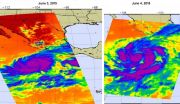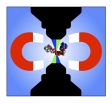What are Medicare costs for patients with oral cavity, pharyngeal cancers?
2015-06-04
(Press-News.org) Medicare costs for older patients with oral cavity and pharyngeal cancers increased based on demographics, co-existing illnesses and treatment selection, according to a report published online by JAMA Otolaryngology-Head & Neck Surgery.
Many cases of oral cavity cancer and most cases of pharyngeal cancer are diagnosed at advanced stages when management of the disease is complex and treatment is aggressive and involves multiple specialists. The publicly funded Medicare program provides an opportunity for researchers to estimate the cost of care for older patients with these cancers.
Christopher S. Hollenbeak, Ph.D., of the Pennsylvania State University, Hershey, and coauthors analyzed data from Medicare and Surveillance, Epidemiology and End Results hospitals from 1995 through 2005 in patients 66 years and older with oral cavity cancer (6,724 patients) and pharyngeal (3,987 patients) cancers. The authors measured five-year cumulative costs after initial diagnosis, which were defined as Medicare Parts A and B payments.
The results show:
Compared with white patients, on average, African-American patients with oral cavity cancer accumulated $11,450 more in costs and African-American patients with pharyngeal cancer racked up $25,093 more.
The number of co-existing illnesses impacted average five-year cumulative costs: one or two co-existing illnesses increased average cumulative costs by $13,342 for patients with oral cavity cancer and $14,139 for patients with pharyngeal cancer; three or more co-existing illnesses increased costs by $22,196 for patients with oral cavity cancer and $27,799 for patients with pharyngeal cancer.
Treatment selection was a determinant of cumulative costs. Patients who had chemotherapy accumulated an average of $26,919 more in costs by five years for oral cavity cancer and $37,407 more for pharyngeal cancer.
The authors note their results cannot be generalized to younger patients because Medicare data was used. They also point out that outpatient drug costs were not included in the estimates because Medicare did not reimburse for drugs during the study period.
"With an attributable cost of $27,000 for patients with oral cavity cancer and $40,000 for pharyngeal cancers, there are substantial costs attributable to this disease. Although any comprehensive effort to reduce the economic burden of oral cavity and pharyngeal cancers must emphasize preventive and early diagnostic measures given the role of comorbidities and treatment modality as the primary determinants of cumulative costs at five years, further research will be needed to understand the cost-effectiveness of different modalities of treatment in patients with varying levels of comorbidities and stage of disease," the study concludes.
INFORMATION:
(JAMA Otolaryngol Head Neck Surg. Published online June 4, 2015. doi:10.1001/.jamaoto.2015.0940. Available pre-embargo to the media at http://media.jamanetwork.com.)
Editor's Note: This study was supported by a grant from the National Institute of Dental and Craniofacial Research, National Institutes of Health. Please see article for additional information, including other authors, author contributions and affiliations, financial disclosures, funding and support, etc.
Media Advisory: To contact corresponding author Christopher S. Hollenbeak, Ph.D., call Matthew G. Solovey at 717-531-0003 x287127 or email msolovey@hmc.psu.edu.
ELSE PRESS RELEASES FROM THIS DATE:
2015-06-04
Placenta doesn't prevent postpartum depression, ease pain, boost energy or aid lactation
Celebrities spike trend, but no studies show human benefits
Unknown risks to women and babies
CHICAGO -- Celebrities such as Kourtney Kardashian blogged and raved about the benefits of their personal placenta 'vitamins' and spiked women's interest in the practice of consuming their placentas after childbirth.
But a new Northwestern Medicine review of 10 current published research studies on placentophagy did not turn up any human or animal data to support the common ...
2015-06-04
One of the instruments that flies aboard NASA's Aqua satellite looks at tropical cyclones using infrared light. In a comparison of infrared data from June 3 and 4, images show that Hurricane Blanca had weakened and became less organized.
The Atmospheric Infrared Sounder or AIRS instrument that flies aboard NASA's Aqua satellite measured cloud top temperatures in Blanca on June 3 at 20:17 UTC (4:23 p.m. EDT) when maximum sustained winds were near 140 mph (220 kph) with higher gusts. At the time, Blanca was a category 4 hurricane on the Saffir-Simpson Hurricane Wind Scale. ...
2015-06-04
DURHAM, NC -- There aren't any giants or midgets when it comes to the cells in your body, and now Duke University scientists think they know why.
A new study appearing June 3 in Nature shows that a cell's initial size determines how much it will grow before it splits into two.
This finding goes against recent publications suggesting cells always add the same amount of mass, with some random fluctuations, before beginning division.
"It's like students going through college," said Lingchong You, the Paul Ruffin Scarborough Associate Professor of Engineering in the ...
2015-06-04
The most aggressive largemouth bass in the lake are also the ones most prized by anglers. These are the fish that literally 'take the bait' and put the fun into both competitive and casual sport fishing.
Then, according to the rules of catch-and-release, the captive is unhooked and tossed back to swim away without any lasting consequences. But a new UConn study says there is an impact; the evolutionary path of a species may be on the line.
In a recent paper published in the journal PLOS ONE, a team of researchers led by Jan-Michael Hessenauer and Jason Vokoun of the ...
2015-06-04
Armed with new knowledge about how neurodegenerative diseases alter brain structures, increasing numbers of neurologists, psychiatrists and other clinicians are adopting quantitative brain imaging as a tool to measure and help manage cognitive declines in patients. These imaging findings can help spur beneficial lifestyle changes in patients to reduce risk for Alzheimer's disease.
The concept that cognitive decline can be identified early and prevented by applying quantitative brain imaging techniques is the focus of "Hot Topics in Research: Preventive Neuroradiology ...
2015-06-04
ATLANTA - June 4, 2015- Screening for colorectal cancer increased in lower socioeconomic status (SES) individuals after 2008, perhaps reflecting the Affordable Care Act's removal of financial barriers to screening according to a new analysis. The study, by American Cancer Society investigators, appears online in the journal Cancer.
The Patient Protection and Affordable Care Act (ACA) included a cost-sharing provision intended to reduce financial barriers for preventive services, including screening for colorectal cancer (CRC) and breast cancer (BC). To investigate whether ...
2015-06-04
Withholding angiotensin receptor blockers (ARBs) for longer than two days after surgery is associated with a significantly increased risk of postoperative death, according to a study of more than 30,000 patients in the VA health care system by researchers at UC San Francisco and the San Francisco VA Medical Center (SFVAMC).
ARBs are prescribed for high blood pressure, heart disease and kidney disease, explained lead author Susan M. Lee, MD, an SFVAMC anesthesiologist and UCSF clinical instructor.
"For non-cardiac surgery, ARBs are commonly stopped on the day of surgery ...
2015-06-04
Researchers at the University of Tokyo have succeeded in developing a new microscope capable of observing the magnetic sensitivity of photochemical reactions believed to be responsible for the ability of some animals to navigate in the Earth's magnetic field, on a scale small enough to follow these reactions taking place inside sub-cellular structures.
Several species of insects, fish, birds and mammals are believed to be able to detect magnetic fields - an ability known as magnetoreception. For example, birds are able to sense the Earth's magnetic field and use it to ...
2015-06-04
The advent of online social networks has led to the rapid development of tools for understanding the interactions between members of the network, their activity, the connections, the hubs and nodes. But, any relationships between lots of entities, whether users of Facebook and Twitter, bees in a colony, birds in a flock, or the genes and proteins in our bodies can be analyzed with the same tools.
Now, research published in International Journal of Data Mining and Bioinformatics shows how social network analysis can be used to understand and identify the biomarkers in ...
2015-06-04
SEATTLE - Physical activities, such as walking, as well as aerobics/calisthenics, biking, gardening, golfing, running, weight-lifting, and yoga/Pilates are associated with better sleep habits, compared to no activity, according to a new study from researchers at the Perelman School of Medicine at the University of Pennsylvania. In contrast, the study shows that other types of physical activity - such as household and childcare -- work are associated with increased cases of poor sleep habits. The full results of the study (Abstract #0246) will be presented during the poster ...
LAST 30 PRESS RELEASES:
[Press-News.org] What are Medicare costs for patients with oral cavity, pharyngeal cancers?


